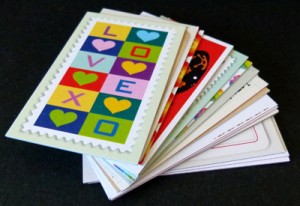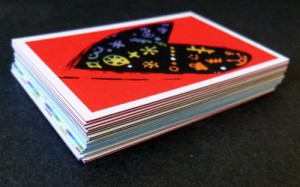PMC is honored to welcome Sabine Lenz from PaperSpecs as a guest blogger! If you love paper, you’ll love Sabine and the awesome information PaperSpecs provides for the print and design community!
 Thick and Delicious Business Cards
Thick and Delicious Business Cards
It was thick. It was juicy. Well, as much as you can call a business card juicy 😉
Award-winning designer Michael Osborne had sent me some promotional business cards he’d designed and – oh my.
The mouth-watering design was digitally printed on a deliciously thick stock with an exposed seam of saturated color. (I’m thinking hot pink center on this choice cut business card.)
Having seen my fair share of double thick, mounted business cards, I was still stunned by the thickness of the card – I’m talking 32-pt. caliper. (Yes, that is thirty-two ladies and gentlemen.)
My curiosity awakened, I found out this was an example of the new Luxe Business Card paper. So I went straight to the source – Jane Monast, director of Communications at Mohawk, to get the inside story.
 Duplex Lamination to the 2nd Power
Duplex Lamination to the 2nd Power
Typically, this thick to super-thick paper effect is achieved by fusing one or more layers of paper together to the desired thickness and quality in a process called laminating or mounting. The two words are often used interchangeably. But many printers prefer to use the term “duplex lamination” or “duplexing” so clients do not confuse this process with the plastic protective coating that office supply stores offer.
But for the Luxe Business Card line, Mohawk had created a unique duplex laminated paper with a twist. It’s a duplex of a duplex!
One half of the card stock is a white sheet of Mohawk Superfine on one side and either cyan, red, white, or black (a variety of sheets from the Via to Carnival lines) on the other side.
So far the sheet is duplex, but here is the beautiful, sneaky twist.
The other half of the card is a mirror image – color stock duplexed with white stock. The colored side is covered with a special glue. After the white side of the sheet has been imprinted digitally, Moo.com, the sole proprietor of this special paper, uses heat and pressure to laminate the two duplexed halves together. Creating a 4-ply card, with the colored sheets sandwiched in the middle.
The result, an intriguing colored strip around the edges of these very thick business cards.
 Hot Melt Glue or White Glue
Hot Melt Glue or White Glue
Super thick business cards are definitely en vogue. If you want to create your own juicy card effect (or have your printer create it) here are some insights to keep in mind.
You start out with two sheets of gorgeous paper. The possibilities here are endless! But when it comes to adhering these layers together at the finishing level, there are really only two choices: white glue or hot melt glue.
Commonly called white glue, polyvinyl resin glue is a close relative of that white stuff we used in grade school. Being a member of the solvent-based adhesive family, as the solvent evaporates, the adhesive hardens.
“We use white glues when we duplex laminate non-porous substrates like plastics or calendared stocks,” explains Scott Gasch, president of Fey Printing and a master laminator in his own right.
Hot melt adhesive, also known as hot glue, is commonly supplied in solid form of various diameters, designed to be melted in a hot electric environment – think of the glue gun concept.
“We use hot melts on the majority of the projects, depending on how porous the substrate is and the type of material being bonded together,” says Gasch.
Hot melt adhesives provide several advantages over solvent-based adhesives. Volatile organic compounds (VOCs) are reduced or eliminated, and the drying or curing step is eliminated. Hot melt adhesives have a long shelf life and usually can be disposed of without special precautions.
“Even within the hot melt adhesive varieties, it requires a bit of testing and trial and error,” advises Gasch. “It’s important to find the correct adhesive otherwise the sheets will eventually delaminate. Factors to consider include the weight of the sheets, the finish of the sheets, and the size of the area to be duplexed.”
Laminating against the grain
But there is another important factor to keep in mind – grain direction.
“If the grain of the top sheet and the bottom sheet run in the same direction, the piece will inevitably curl,” warns Gasch. “By running the grain of the top sheet in one direction and the grain of the bottom sheet in the opposite direction, they fight each other and help the finished piece to lay flat.”
There you have it – a good recipe for those super delicious business cards. Whether you take advantage of Moo.com’s expertise and convenience or have your printer/mill partner create a custom duplex laminated sheet, the trend is hot … and thick and juicy!
———-
Seeing designers worldwide struggle to stay current with new papers and paper trends inspired Sabine Lenz to create PaperSpecs, an independent and comprehensive Web-based paper selection tool and weekly e-newsletter. Growing up in Germany, she started her design career in Frankfurt, before moving on to Australia and the United States. Lenz worked on design projects ranging from corporate identities to major road shows and product launches. From start-ups to Fortune 500 companies, her list of clients included Oracle, Sun Microsystems, Deutsche Bank, IBM and KPMG. Lenz is a noted speaker and author on paper issues and educational topics related to the paper industry.
Copyright 2012 PaperSpecs.com.












2 Responses
Thank you so much for this article! It has me fired up to do some design and to incorporate some “juicy” thick stock! 😀
“Factors to consider include the weight of the sheets, the finish of the sheets, and the size of the area to be duplexed”
What finish exactly? Coated? Uncoated? Something else?.. Is it a good idea to have mine laminated for an added premium feel?